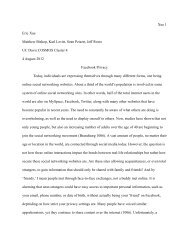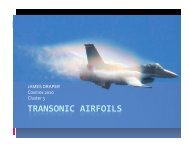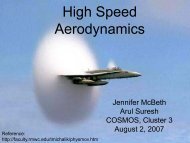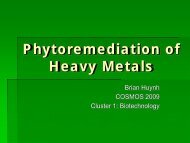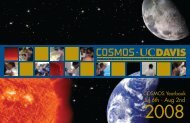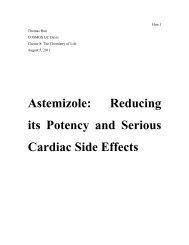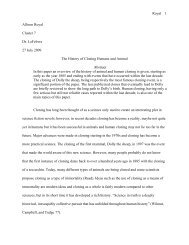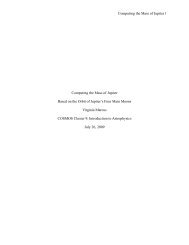Actuators - COSMOS
Actuators - COSMOS
Actuators - COSMOS
You also want an ePaper? Increase the reach of your titles
YUMPU automatically turns print PDFs into web optimized ePapers that Google loves.
<strong>Actuators</strong><br />
Menghsuan (Sam) Pan<br />
Cluster 3
Table of Contents<br />
• Actuator<br />
• History of Actuator<br />
• Motion & Energy of Actuator<br />
• Types of Actuator<br />
• MicroElectoMechanical System<br />
• Internal Combustion Engine<br />
• Jean d'Alembert<br />
• Background & Eduation<br />
• Field Studied<br />
• Contribution
What is an actuator<br />
• A device<br />
convert<br />
energy into<br />
mechanical<br />
energy<br />
MSM actuator
History…<br />
• Industrial Revolution<br />
–18<br />
th century<br />
• Invention of steam engine<br />
marked the beginning of<br />
actuator history.<br />
• 1769<br />
Watt: Fly-ball generator<br />
• 1832<br />
William Sturgeon:<br />
Electric Motor
History… (Cont.)<br />
• 1868<br />
J.C. Maxwell: theory to<br />
predict oscillatory behavior<br />
• 1930s<br />
Charles Kearns :bonded<br />
resistance strain gauges<br />
• 1960s – Resent<br />
MicroEletroMecchanical<br />
System
Motion Created…<br />
• Linear motion<br />
motion in one direction<br />
• Rotary motion<br />
circular motion<br />
• Oscillatory motion<br />
opposite directions at<br />
regular intervals
Power Source<br />
(Mechanical Actuator)<br />
• Air<br />
Pneumatic cylinder<br />
(Air cylinder)<br />
• Electricity<br />
Electric motor<br />
• Liquid<br />
Hydraulic cylinder
Pneumatic cylinder<br />
• Using compressed air or<br />
gas as power source<br />
• Convert potential energy<br />
in compressed air into<br />
mechanical energy.<br />
• Gas pressure<br />
Atmospheric pressure
Electric Motor<br />
• Powered by<br />
electricity and<br />
magnets<br />
• Rotary Motion<br />
• Magnets<br />
poles and<br />
rotation<br />
ti
Hydraulic cylinder<br />
• Powered by pressurized liquid<br />
(Usually oil)<br />
• Piston divides cylinder<br />
into two chambers<br />
• Hydraulic pressure<br />
acts on the piston to<br />
create motion.
Types of <strong>Actuators</strong><br />
• Single-acting actuator<br />
Energy is used in a direction<br />
A spring is used for the other<br />
Hydraulic Single-Acting Valve Actuator
Types of Actuator<br />
• Double-acting actuator<br />
Energy is used in both directions<br />
Hydraulic Double-Acting Valve Actuator
MicroElectroMechanical<br />
System<br />
(MEM)<br />
• Microfabrication technology<br />
Fabrication of miniature structures<br />
(micrometer size).<br />
• Micromachining<br />
Fabricated in manner<br />
of integrated circuits<br />
• Silicon substrates<br />
Slice of semiconductor<br />
material
Microactuator<br />
• A microscopic servomechanism<br />
• Classes of microactuators<br />
Electrostatic<br />
Electromagnetic<br />
Piezoelectric<br />
Fluid
Piezoelectric Actuator<br />
• Transducers convert<br />
electrical energy into<br />
mechanical energy<br />
• Precision positioning<br />
mechanism<br />
• High electrical capacity<br />
• Piezoelectric i buzzer<br />
• Inkjet head<br />
• ultrasonic motor
Micromirror<br />
• Mirrors in microscopic world<br />
• Fiber optics<br />
• Light beams will reflect off micromirror into a<br />
fibre. If micro-mirror mirror has been actuated, beam<br />
will be sent to a different fibre.
Internal Combustion Engine<br />
• Use Chemical<br />
Energy as power<br />
source<br />
• When Chemical<br />
reaction occurs,<br />
pressure will<br />
increase and<br />
mechanical energy<br />
will be created.
Rotary Engine<br />
• A type of internal combustion engine<br />
• Use the pressure increase as power<br />
source when fuels<br />
are burned.<br />
• Triangular rotor<br />
• Mazda RX-7
Jean Le Rond d'Alembert<br />
(1717 – 1783)<br />
• Thus metaphysics and<br />
mathematics are, among all<br />
the sciences that belong to<br />
reason, those in which<br />
imagination has the greatest<br />
role. I beg pardon of those<br />
delicate spirits who are<br />
detractors of mathematics for<br />
saying this .... The imagination<br />
in a mathematician who<br />
creates makes no less<br />
difference than in a poet who<br />
invents.... Of all the great men<br />
of antiquity, Archimedes may<br />
be the one who most<br />
deserves to be placed beside<br />
Homer.
Background<br />
• Born: 17 Nov 1717<br />
in Paris, France<br />
• St Jean Le Rond Church<br />
• Died: 29 Oct 1783<br />
in Paris, France<br />
• Mme Rousseau<br />
Mother in d’Alember’s eye
Education<br />
• A private school<br />
• Destouches family<br />
• Jansenist Collège des<br />
Quatre Nations<br />
• Daremberg<br />
• d'Alembert
Study Field<br />
• Mathematics<br />
• Mechanics<br />
• Physics<br />
• Philosophy<br />
• Theology<br />
• Law<br />
• Medicine
Contribution<br />
• Fluid mechanics<br />
• D'Alembert's principle<br />
p<br />
• D'Alembert's formula<br />
• D'Alembert's paradox<br />
• Encyclopédie
D'Alembert's principle<br />
• Alternative form of Newton’s Second Law<br />
• F − ma = 0<br />
• Reduce the situation from dynamics to<br />
statics.<br />
• Created a imaginary force opposite and<br />
equal to the force acting on the object<br />
• Resulting a kinetic equilibrium
D'Alembert's Solution<br />
• The method of d'Alembert provides a solution to the one-<br />
dimensional wave equation<br />
• that models vibrations of a string.<br />
• The general solution can be obtained by introducing new variables<br />
obtain<br />
and , and applying the chain rule to<br />
(<br />
4<br />
)
DAlembertsSolution<br />
D'Alembert's (Cont.)<br />
• respectively, so plugging in and expanding then gives<br />
• This partial differential equation has general solution<br />
• where and are arbitrary functions, with representing a right-<br />
traveling wave and a left-traveling traveling wave.
DAlembertsSolution<br />
D'Alembert's (Cont.)<br />
• The initial value problem for a string located at position<br />
as a function of distance along the string and<br />
vertical speed can be found as follows.<br />
From the initial<br />
• Taking the derivative with respect to t then gives<br />
• and integrating gives
DAlembertsSolution<br />
D'Alembert's (Cont.)<br />
• the solution to the wave equation with specified initial conditions<br />
as
D'Alembert's paradox<br />
• Drag is “ZERO” on a<br />
body moving with<br />
constant t velocity<br />
relative to fluid.<br />
• Three Assumption<br />
• Flow is<br />
• 1) incompressible<br />
• 2) inviscid<br />
• 3) irrotational
D'Alembert's paradox (Cont.)<br />
• The pressure is<br />
symmetrical around<br />
the sphere.<br />
• The paradox is due<br />
to the neglect of the<br />
effects of the effect<br />
of viscosity.
References<br />
• http://www.wisegeek.com/what-is-an-actuator.htmactuator.htm<br />
• http://www.tkk.fi/Units/AES/projects/prlaser/actuators.htm<br />
p p<br />
• http://www.directindustry.com/prod/edrive-design/electric-ball-screw-linear-actuator-17414-<br />
354093.html<br />
• http://china.rs-<br />
online.com/web/search/searchBrowseAction.htmlmethod=getProduct&R=2224084#header<br />
• http://ieeexplore.ieee.org/stamp/stamp.jsparnumber=01325416<br />
p p p p<br />
• http://www.gearseds.com/curriculum/learn/lesson_print.phpid=101<br />
• http://www.mathworks.com/access/helpdesk/help/toolbox/physmod/hydro/ref/<br />
• http://electronics.howstuffworks.com/motor.htm<br />
• http://www.mems-exchange.org/MEMS/what-is.html<br />
• http://mae.ucdavis.edu/dahorsley/<br />
edu/dahorsley/<br />
• http://auto.howstuffworks.com/engine1.htm<br />
• http://auto.howstuffworks.com/rotary-engine.htm<br />
• http://www.electronics-manufacturers.com/products/sensors-transducers-<br />
detectors/piezoelectric-actuator/<br />
• http://webdocs.cs.ualberta.ca/~database/MEMS/sma_mems/mirror.html<br />
t / d t b /MEMS/ / l<br />
• http://www-history.mcs.st-and.ac.uk/Mathematicians/D%27Alembert.html<br />
• http://www.britannica.com/EBchecked/topic/150132/dAlemberts-principle<br />
principle<br />
• http://mathworld.wolfram.com/dAlembertsSolution.html<br />
• http://www.absoluteastronomy.com/topics/D%27Alembert%27s p _p<br />
paradox




